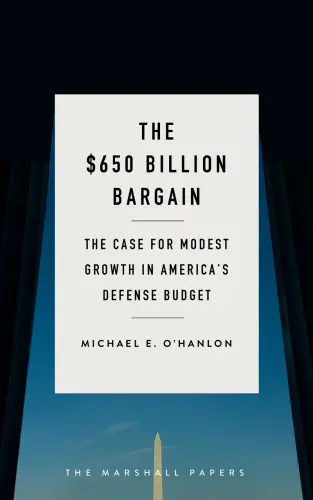In response to reports that President Donald Trump will ask Congress for $716 billion in national defense funding for 2019, Michael O’Hanlon puts the number in perspective and offers a proposal: Give Trump most or all of his defense buildup, but in a way that makes it temporary. This piece originally appeared in The Hill.
According to news reports, President Donald Trump will soon ask Congress for $716 billion in national defense funding for 2019 as part of his broader budget request to the Congress.
That figure, which includes war costs as well as the Department of Energy’s nuclear weapons activities, is a whole lot of money; more than I would advise, to be sure.
But despite its effects on the deficit, there is a way for Democrats and Republicans to compromise on future military spending in a way that would provide key defense resources for a few years without permanently blowing up the nation’s fiscal position.
First, some perspective. How much is $716 billion, actually? A few reference points may help. Some comparisons make Trump’s reported 2019 request seem not so gargantuan or unprecedented:
- $700 billion is allotted for this year’s defense budget, as passed last year by Congress and signed into law by President Trump, even though it has not actually taken effect yet due to the ongoing budget impasse in Washington.
- About $775 billion typified the latter Bush and early Obama years at the peak of the war efforts in inflation-adjusted, 2018 dollars.
- The total makes up just under 3.5 percent of gross domestic product. Compare that to Cold War norms of 5 to 10 percent.
But when referenced against other benchmarks, the Trump request would in fact look quite large:
- The Cold War average budget was just under $550 billion, including war costs and adjusted for inflation.
- The Reagan peak was some $650 billion. Yes, that’s right. Trump’s budget would exceed Reagan’s biggest.
- China’s total military spending is about $200 billion to $225 billion, and Russia’s is some $50 billion to $60 billion (the rest of NATO’s cumulative total is a bit more than $250 billion, by the way).
- President Obama’s projection for 2018 (as part of his last long-term Pentagon budget plan) was about $645 billion.
- President Trump’s own earlier proposal for 2018—before Congress matched his bid and raised him for the year—was about $665 billion.
So there is grist for a good debate about whether this new budget would be generous but reasonable or wasteful and somewhat profligate. There certainly are plenty of ways to spend the money usefully. Our troops today are reasonably well paid, but they should be given what we ask of them and their families, and overall compensation should be sustained.
Military readiness is far better than in the 1970s, but it is worse than in the 1980s and 1990s, after years of war (and of Washington budgetary shenanigans). For example, some types of equipment have “mission-capable rates” in the range of 50 to 60 percent, due to maintenance backlogs, when we really need 80 to 90 percent.
While procurement budgets are now reasonably healthy (at more than $125 billion a year), they were suppressed for so many years after the Cold War that there is a lot of aging equipment we still need to modernize.
One downside to rapid defense build-ups, however, is that they tend to discourage reforms by removing the incentive to make painful choices.
Even as drones have come into their own and aircraft like the A-10 “Warthog” continue to prove their mettle in the Middle East, the military services continue to insist on buying the same number of F-35 fighters (almost 2,500) that they did more than a decade ago.
Congress continues to resist authorizing additional rounds of base closures, even though inventory exceeds need by at least 20 percent according to the military services.
All three legs of the nuclear triad are being targeted for modernization nearly simultaneously, when there are probably ways to economize or delay plans for ICBM modernization. Improved means of maintaining weaponry efficiently, such as “performance-based logistics,” can and should be adopted more widely across the department. The list goes on.
Of course, the other elephant in the room is the country’s fiscal plight. With tax cuts, no entitlement reforms and this defense buildup, the deficit will remain in excess of $600 billion even with an economy chugging along on all cylinders.
Publicly held debt will remain at 75 percent of GDP; debts, deficits and interest payments will grow significantly as soon as there is a slowing economy or a substantial rise in interest rates. This combination will not make America greater again and will constrain our pursuit of other national priorities like infrastructure improvement.
Here is a modest proposal, which also bows to political reality: Give Trump most or all of his defense buildup but in a way that makes it temporary. In addition to the supplemental funds now provided for the wars through the “Overseas Contingency Operations” account, which go largely to Afghanistan, Iraq and Syria, create a “Deterrence Restoration Account.”
These would also be emergency funds, but they would temporarily help fund Secretary of Defense Mattis’s key priorities of restoring strong deterrence of Russia and China, as underscored in his new National Defense Strategy.
Given recent behavior by Russia in particular, this would be an appropriate and necessary signal to send leaders in Moscow as well as other capitals about American resoluteness. But it would not create a permanently higher defense budget.
With this concept, Trump would get most or all of his $716 billion for 2019, but $35 billion to $40 billion of it (roughly the amount Congress also added to his original 2018 request) would be in a fund that would wind down by the end of this presidential term.
Any defense increase beyond 2021 would require a fresh debate and a comparison of defense needs with all those other priorities in the federal budget. That’s the way Washington decisions are supposed to be made.
Given today’s circumstances, however, we need a prudent way to avoid endless disagreements, government shutdowns and other outcomes that weaken America at a particularly inopportune time.








Commentary
Permit (part of) Trump’s defense buildup without blowing up the deficit
January 31, 2018